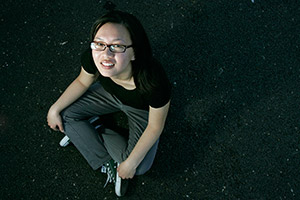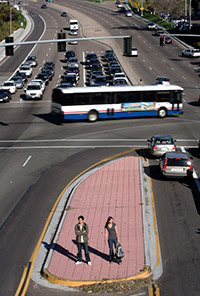Green Social Sciences Courses Fill with Students
Inga Kiderra | December 14, 2009
If you “green” an undergraduate course, will students come? In UC San Diego’s Division of Social Sciences, the answer is yes, demonstrated by filled-to-capacity classes with environmental content in the departments of Economics, Ethnic Studies, Sociology and Urban Studies. More and more student projects are focusing on sustainability, too.
Urban studies and planning (USP), one of the oldest interdisciplinary undergraduate majors at UC San Diego, underwent a major greening of its curriculum in 2002-3, with new classes such as “Sustainable Planning” added to complement existing courses like “Sustainable Development.”
The number of USP majors – many of them environmentally oriented – has grown from 78 in 2001 (before the curriculum change) to 170 in 2009, said USP Program Director Steve Erie.
Keith Pezzoli, the USP program’s field studies supervisor who teaches the senior sequence, says that students majoring in urban studies and planning are increasingly choosing to focus on green or sustainability challenges in their research practicum requirement.
“The type of environmental projects that USP students do has a strong field research and service learning component,” Pezzoli said. “The diversity of their projects is impressive – including landscape ecology, greening of buildings, regional habitat conservation planning, integrated watershed management, climate change, environmental justice and policy-making, among a wide range of other topics.”

For several years, the San Diego Union-Tribune has been covering Urban Studies' annual EXPO, in which many of the student projects examine environmental challenges. In 2009, for example, Christine Wang looked into pervious pavers as an alternative asphalt on parking lots to reduce urban water runoff into storm drains.
(Photo / Earnie Grafton, Union-Tribune)
A sample of these projects can be viewed on the SciVee website. Also, for several years now, the San Diego Union-Tribune’s Roger Showley has been covering the program’s annual EXPO. His stories for 2008 and 2009, to take just the latest two, include discussion of several of the students’ efforts on environmental topics – from a proposal on better intersection signalization to lower gasoline consumption to a call for more small-parcel community gardens.
Over the past five years, Pezzoli added, “a growing number of USP students have been playing a significant role in a major urban-ecological restoration project along the U.S.-Mexico border.” This project is the subject of a UCSD-TV documentary, created in partnership with USP and UCSD's Superfund Research Program, which was released in November 2009. Titled “Los Laureles Canyon: Research to Action,” the documentary features, in addition to faculty, several passionately engaged students; it can be viewed online. (For even more on the project, in its earlier days, see “Saving the Tijuana River Estuary.”)
The Department of Economics, said Richard Carson, a recent department chair and a past president of the American Association of Environmental and Resource Economists, has a very strong grouping of faculty and course offerings in environmental economics. He cited five courses “with a principle emphasis on environmental issues,” plus six more with “substantial environmental content.”

Pictured at a busy intersection on La Jolla Village Drive, UCSD students Jason Runyan, 21, and Becky Trayer, 22, examined transportation issues in their urban studies and planning major.
(Photo / Crissy Pascual, Union-Tribune)
Since economics is the university’s second most popular major – with 2,444 students in 2008, or about 11 percent of the campus’ total undergraduate student population – Carson said he suspects that the department “graduates the largest number of people in the social sciences with an interest in obtaining employment in this area.” Economics graduates, he noted, routinely take jobs in private firms, government agencies at all levels and non-profit organizations working on environmental topics.
Student interest seems only to be rising. Rafael Acevedo, director of student affairs in the Economics Department, said that “Economics of the Environment” and “Energy Economics,” for example, saw a 16 percent rise in enrollments from 2007-8 to 2008-9. The increase from 2007-8 to 2009-10 is projected to be 40 percent, with the two courses together accounting for some 459 students in fall and winter of this academic year.
Acevedo noted, too, that student demand for environmental economics is so strong that the department created “Economics of Conservation” in 2008-9 and 252 students enrolled the first time it was offered.
Also in 2008-9, the Center for Environmental Economics was launched. Headed by Theodore Groves, the center promotes research in environmental economics and provides a community for interested scholars (across the university). Though the center has been focused mostly on faculty and graduate-student scholarship, Groves said, it has begun to reach out to undergraduates and offer them research opportunities. This winter quarter, Groves himself will be supervising an undergraduate-directed research project investigating the economics of water in San Diego County. A report from this project, he said, will be issued by the center.
Read related stories on UC San Diego gravitating towards Green:
In the Department of Sociology, too, there is demonstrable student interest in green topics. April Linton, for example, has been offering a freshman seminar since 2005-6 on the social and environmental impacts of buying clothes and food called “Global Citizens or Global Consumers? Linking Your Conscience and Your Wallet.” She also teaches a senior seminar called “What’s for Dinner? Local and Global Perspectives on Ethical Food Consumption.” Ivan Evans meanwhile teaches a popular senior seminar about oil and the Middle East.
Sociology Department Chair Richard Madsen said “it would be hard to talk about a recent rise in popularity,” because he believes the courses have always been completely filled.
Ethnic studies department Chair Yen Espiritu agrees that “the issues of environmentalism and sustainability are becoming more and more popular.” And, she said, several of the department’s honors students are pursuing the subject.
“Students are passionate about environmental politics and policy, and eager to find interdisciplinary ways to produce solutions to environmental problems, as well as to apply critical analysis to those problems,” she said. “What our department provides is a critical examination of environmental issues, both in terms of how communities of color are disproportionally affected by environmental degradation, and how sustainability efforts often neglect or further harm communities of color.”
Over the years, Espiritu said, the Ethnic Studies Department has seen enrollment in its “Environmental Racism” course double and triple.
Unfortunately, she added, the professor who used to teach the class and is a leading expert on the subject left for another school. Due to the current University of California budget crisis and consequent hiring freeze, the department has so far been unable to replace him and continue offering this important class.

|